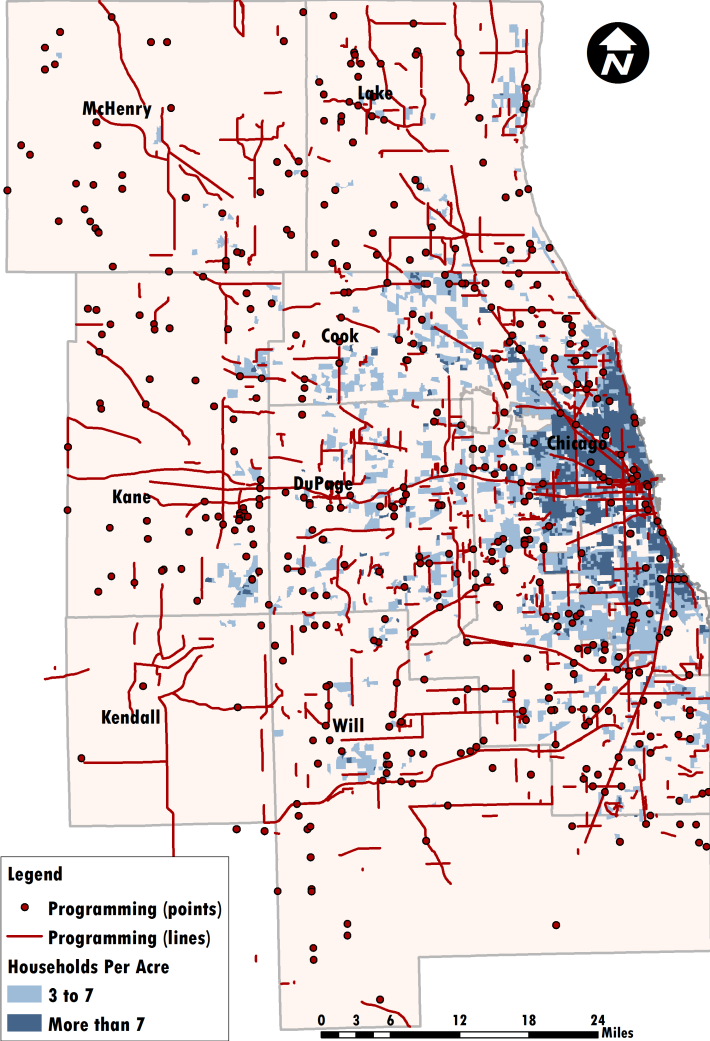
The Center for Neighborhood Technology, a local community planning think tank, said that municipalities and public agencies are failing to follow their own plans. They're investing public funds for the region in economic development and transportation projects in undeveloped areas or away from train stations.
CNT wrote in their new report, "Putting Places First," that money is instead spent on repaving or enlarging roads, and projects that a municipality may already be comfortable building, even if that's contrary to their adopted plan. The report said that the mindset about how we implement projects needs to change: "even though stakeholders increasingly agree about the need to stop sprawl, and communities make plans for more compact growth, implementation crawls."
Chicagoland's comprehensive plan, GO TO 2040, says that the 284 municipalities in its coverage area – all of whom voted to adopt the plan five years ago – should create walkable communities around transit or in vacant areas as infill development. The problem, the report said, is that each of the municipalities "must still navigate a complex web of funding streams, allocation criteria, and application schedules to get the money they need to play their roles in making this regional vision a reality."
Turning the regional plan into a series of supportive, local plans has been successful, the report said, because the Chicagoland Metropolitan Agency for Planning's Local Technical Assistance program and the Regional Transportation Authority's Community Planning initiative have paid for and created 289 neighborhood and city-level plans since 1998. Municipalities have also created many plans on their own.
"We have plans in place, hundreds of them, that demonstrate local support to grow more compactly, near transit, and in line with GO TO 2040," said Kyle Smith, a planner at CNT and who wrote the report. "But we're not promising communities the resources they need to implement these plans."
Funding isn't tied to planning

Much of the money to build projects that would implement those plans, and in GO TO 2040, comes from federal sources and is controlled regionally and locally. These sources can pay for bike lanes, train station upgrades, and road diets.
Surface Transportation Program funds are sub-allocated to the City of Chicago and 11 Councils of Mayors, but "without a unified strategy or vision," and some of the councils prefer spending the money to enlarge or repave roads, Smith said.
The projects that the cities and councils apply for are the ones that get funded, not the ones that support "broader economic development goals" because municipalities don't currently have the staff capacity or monetary ability to design projects that implement their plans, or can't generate matching funds.
Funds from the Congestion Mitigation and Air Quality program have different problems, and the report makes an indictment of the process to select projects.
...every CMAQ dollar allocated to an intersection or parking project equals one fewer dollar for [transit-oriented development] projects than can generate bigger benefits by reducing reliance on cars and trucks, lowering air pollution, and better utilizing the infrastructure the region already has to anchor community growth.
I reported two months ago that too much of the "air quality" program was enlarging roads to hold more cars. That's money not spent on projects that improve walking, bicycling, and access to transit.
CMAP took a step to better align funding awards with GO TO 2040 priorities: "In 2014, CMAP created new criteria for transit projects that reward communities already zoned for [transit-oriented development]," and municipalities responded, according to the CNT report. CMAP awarded funds for 19 of 28 applied-for projects that were part of TOD plans funded by the RTA.
Still, Smith wrote, even though the method by which CMAQ funds are distributed are more transparent and aligned with plan priorities compared to STP project selection, "the influence of entrenched interests on programming decisions has led to scoring criteria that only modestly reflect [GO TO 2040] goals."
Projects are built away from people
The report illustrated these gaps between funding priorities and funded transportation projects. They're built away from where people live or work, in low density areas, and in a few corridors. About 45 percent of the funds have paid for projects "exclusively for cars and without pedestrians in mind" within a 10 minute walk of a train station.
Only 14 percent of funds for projects near train stations went to projects that facilitate more biking and walking. The report said, "In fact, there have been more road resurfacing projects in TOD areas than bike and pedestrian or mixed-use projects."
"It shouldn't take a talented planner to figure out how all of these programs work, how to submit a competitive application, and how to bundle them together," Smith said. "Our implementation resources should be targeted to plan implementation as a standard order of practice."
Implementers should invest in the same places
CNT recommends creating "Priority Development Areas" – distributed equitably across the region and chosen by municipal leaders – so that investments from different sources and levels of government are made in the same place to support the existing plans.
Every CMAQ award should originate from a plan, and "at least one half of CMAQ investments should be targeted to plan implementation in PDAs where communities have a clear economic development vision."
STP funds that can be spent on repaving roads, on the other hand, should be capped so that municipalities will find other sources so that they'll have the incentive to spend this money on "more transformative projects."
Making sure that the projects that get built actually implement existing plans should ensure the region can achieve its collective vision of walkable communities and reduced reliance on driving.
![]()
Did you appreciate this post? Streetsblog Chicago is currently funded until April 2016. Consider making a donation through our PublicGood site to help ensure we can continue to publish next year.




